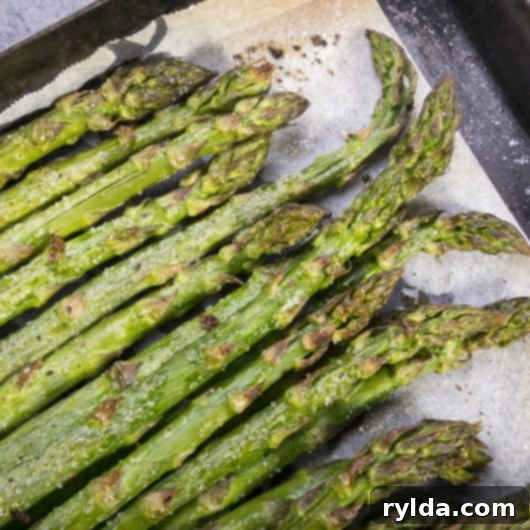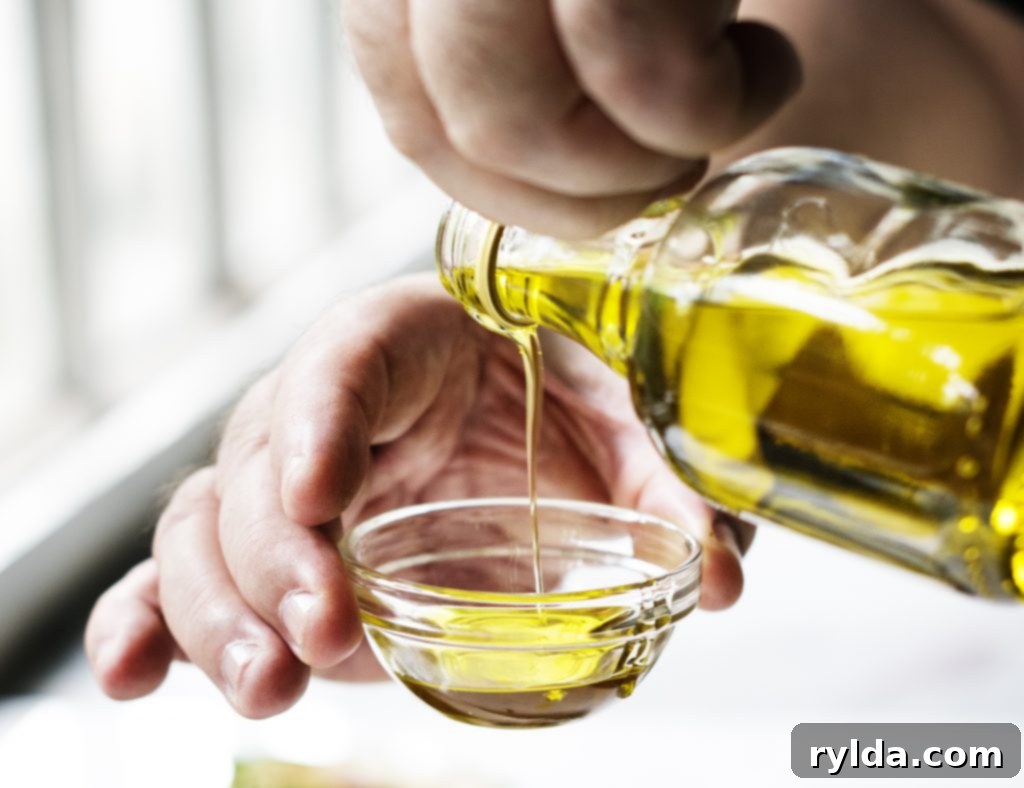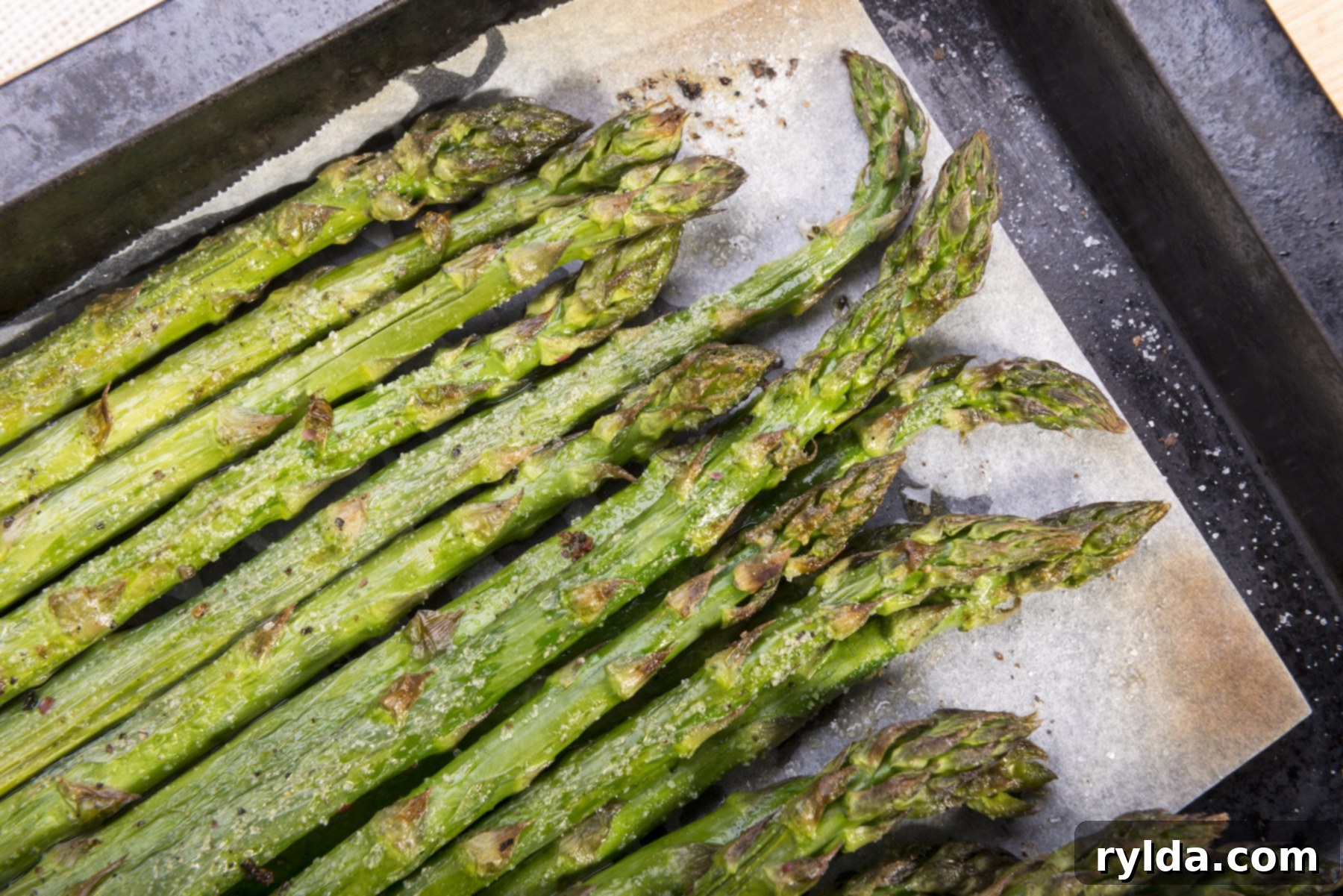Foolproof Roasted Asparagus: Your Ultimate Guide to Perfectly Tender, Flavorful Spears Every Time
Roasted asparagus is more than just a side dish; it’s a culinary revelation that, once mastered, will become a beloved staple on your dinner table. This particular recipe, affectionately dubbed “Foolproof Roasted Asparagus,” stands out for its undeniable simplicity and consistently perfect results. Over the years, I’ve shared this method with countless friends and family members, and even my husband, who rarely ventures into the kitchen, has successfully transformed fresh asparagus into a delicious, tender, and perfectly seasoned treat using these very steps. It’s not just a claim; it genuinely lives up to its “foolproof” title, making it the ideal choice for anyone seeking an easy yet impressive vegetable side.
While the vibrant green spears of asparagus truly shine in the spring and early summer months, its broader availability means fresh, good-quality asparagus is now a delightful option year-round. This versatility allows you to enjoy this quick and healthy vegetable any time you desire. From festive holiday spreads like Easter, July 4th, Thanksgiving, and Christmas to everyday weeknight dinners, it’s always a welcome addition. I particularly love how incredibly fast it comes together—from minimal prep to a perfectly roasted plate in under 20 minutes! This makes it the ideal companion to toss into the oven while your main course, perhaps a succulent roasted chicken or a perfectly seared steak, is resting. You’ll have a steaming hot, fresh, and vibrant vegetable side dish ready to serve just as you plate the main event, adding a burst of color and exquisite flavor to any meal.

The Secret to Tender Asparagus: Mastering the Trim
If you’re new to cooking fresh asparagus, there’s a crucial piece of knowledge that will elevate your dishes from mediocre to magnificent: not all parts of the asparagus spear are created equal. The lower part of the stem, closer to where it was harvested, tends to be considerably tougher, stringier, and more “woody.” This fibrous section is not pleasant to chew, and if you’ve ever had a dining experience where asparagus felt like a battle, it’s likely due to improper preparation. The goal is to discard this tough base and enjoy only the tender, succulent portion of the spear, ensuring every bite is a pleasure.
Fortunately, nature has an ingenious way of guiding us. The traditional and highly effective method for finding the perfect trim point is the “bend-and-snap.” To do this, simply hold an asparagus spear near the tip with one hand and near the base with the other, applying gentle, even pressure. The spear will naturally break at the precise point where the tough, woody stem transitions into the tender, edible portion. This natural breaking point is your infallible signal for where to cut. It’s an intuitive method that guarantees you’re only eating the best, most palatable part of the vegetable, ensuring a delightful texture in your finished dish.
Now, while the bend-and-snap method is perfect for individual spears, who has the time to meticulously snap an entire bunch of asparagus when dinner needs to be on the table in minutes? This foolproof recipe incorporates a brilliant time-saving shortcut for trimming that maintains quality without sacrificing efficiency. Instead of painstakingly snapping each spear, I recommend testing just two or three spears from your bunch using the bend-and-snap method. Once you’ve identified the shortest break point among these, gather the entire bunch of asparagus together and, with a sharp chef’s knife, simply chop off all the bases at that shortest length. You might feel like you’re sacrificing an extra inch or two of potentially edible asparagus this way, but the time saved is invaluable, and the slight cumulative loss is well worth the efficiency and convenience. This quick-chop technique ensures uniform cooking and saves you precious minutes, making this recipe truly practical for any busy cook and reinforcing its “foolproof” reputation.

Foolproof Roasted Asparagus
3.5 from 53 votes
4
servings
5
minutes
14
minutes
Ingredients
-
1 bunch 1 Asparagus, fresh, any variety
-
2 tablespoons 2 Extra virgin olive oil
-
1 teaspoon 1 Sea salt
-
Black pepper, fresh ground; to taste
Directions
- Preheat oven to 425° F (220° C). Line baking sheet or roasting pan with parchment or foil.
- Rinse asparagus. Discard any spears with mushy or squishy tips. Shake off excess water over sink, but do not dry. Place on cutting board.
- Test 2 or 3 asparagus for desired trim length. To do this, hold a spear by the tip with one hand and by the stem with the other. exerting even pressure, bend the spear until it snaps. Repeat with 1-2 more stems from the bunch. Cut the rest of the asparagus to the length of the shortest broken spear.
- Place asparagus on pre-lined baking sheet or roasting pan. Pour extra virgin olive oil over asparagus. Toss asparagus in oil until completely covered; it may be easiest to toss it by hand.
- Sprinkle sea salt and fresh ground black pepper over asparagus, tossing gently to coat evenly.
- Ensure asparagus lies in single layer in bottom of pan with no overlap.
- Place pan in preheated oven. Roast for 10-14 minutes or until asparagus reaches desired doneness. Remove from oven and serve immediately.
Notes
- This recipe works for any variety of asparagus, including white.
- Asparagus spear widths can vary widely from almost needle-thin to the thickness of your thumb. This recipe will work for any width of spear, but use your best judgement for cooking times. Super thin spears may cook faster than time prescribed. Super thick spears may require more time.
- Any type of sea salt or Kosher salt may be used for this recipe. If using table salt, reduce salt amount to taste.
- Extra virgin olive oil is recommended as the asparagus finishes cooking before smoke point is reached. Other types of oil, like light olive oil, or vegetable oil may be substituted; taste will change.
- Oil distributes more easily when asparagus is still damp from rinsing, however recipe will still work with dry asparagus that has already been rinsed and dried.
- Frozen asparagus is not recommended for this recipe.

Why This Recipe Is Truly Foolproof: Tips & Tricks
One of the intriguing quirks of this recipe, which might seem counter-intuitive to conventional cooking wisdom, is its recommendation to use slightly damp asparagus. Typically, when roasting vegetables, chefs often advise patting them completely dry to ensure optimal browning and a crispy exterior. However, in my extensive experience with this particular method, allowing the asparagus to retain a little moisture from its rinse actually helps the olive oil adhere more effectively to each spear. While oil and water famously don’t mix on a macroscopic level, a thin film of water on the surface of the asparagus seems to facilitate a more even and thorough coating of the oil. This, in turn, I believe contributes to a superior roast, resulting in beautifully tender interiors and perfectly caramelized exteriors. It’s a subtle difference, perhaps not entirely backed by strict scientific analysis, but the consistently delicious results speak for themselves, and I’m thoroughly convinced of its benefit!
The success of this foolproof roasted asparagus also lies in the carefully chosen high roasting temperature of 425°F (220°C). This high heat is crucial because it allows the asparagus to cook quickly, preserving its vibrant green color and delicate texture, while simultaneously promoting a lovely caramelization on the exterior. This process brings out the natural sweetness of the vegetable, adding depth to its flavor profile. Don’t be tempted to lower the temperature or shorten the cooking time too much, as this might result in either undercooked, tough spears or a lack of that desirable roasted character. The 10-14 minute window provides a perfect balance for most spear thicknesses, ensuring they are tender-crisp – soft enough to bite through easily, but still possessing a pleasant al dente snap, a hallmark of perfectly cooked asparagus.
Essential Ingredients and Flavor Variations
At its core, this recipe uses a minimal number of high-quality ingredients to let the natural, delicate flavor of the asparagus truly shine. You’ll need fresh asparagus (any variety works beautifully, from the common vibrant green to the more delicate white or purple varieties), good extra virgin olive oil, sea salt, and fresh ground black pepper. When selecting your asparagus, always prioritize freshness: look for firm, bright green (or white/purple, depending on variety) spears with tightly closed, compact tips. Avoid any that appear limp, dull in color, or have soft/mushy tips, as these are clear signs of age and will not yield the best results in terms of flavor or texture. The thickness of the spears can vary widely, from pencil-thin to as thick as your thumb; while this recipe accommodates all, remember that cooking times will need slight adjustments based on their girth.
Extra virgin olive oil is highly recommended not only for its superior flavor profile but also because it performs exceptionally well at the given roasting temperature without quickly reaching its smoke point. Its fruity, slightly peppery notes complement the asparagus beautifully, enhancing its inherent taste. While you can substitute with other oils like light olive oil, avocado oil, or even a neutral vegetable oil, be aware that the overall flavor profile of the dish will subtly change. For seasoning, sea salt or Kosher salt are preferred for their coarser texture and clean taste, which distribute evenly and adhere well to the oiled spears. If using standard table salt, you’ll want to reduce the amount as it’s much finer and saltier by volume, so adjust to your personal taste.
While a simple toss with salt, pepper, and olive oil creates a classic and universally loved dish, don’t hesitate to experiment with flavor variations to suit your palate or meal theme. A squeeze of fresh lemon juice or a sprinkle of lemon zest added after roasting can impart a bright, zesty finish that really awakens the flavors. A dash of garlic powder or finely minced fresh garlic tossed with the oil can introduce a wonderfully savory depth. For a touch of richness and indulgence, consider a sprinkle of grated Parmesan cheese in the last few minutes of roasting, or a drizzle of sweet and tangy balsamic glaze after it comes out of the oven. Even a pinch of red pepper flakes can give it a subtle, pleasant kick. The true beauty of this foolproof recipe lies in its adaptability, serving as a perfect and versatile canvas for your culinary creativity.
Beyond the Basics: Tips for Perfect Roasting Every Time
Achieving perfectly roasted asparagus goes beyond just the ingredients and precise timing; how you arrange the spears on the baking sheet plays a pivotal role in the final texture. For optimal roasting and that desirable tender-crisp texture with slightly caramelized, flavorful edges, it’s absolutely crucial that the asparagus lies in a single layer at the bottom of the pan, with no overlap whatsoever. Overcrowding the pan is a common mistake that leads to steamed, rather than properly roasted, vegetables. When asparagus spears are piled on top of each other, they release their natural moisture, creating steam that prevents proper browning and can result in soggy, pale, and ultimately unappealing textures. If you’re cooking a large batch, it’s always better to use two separate baking sheets or roast the asparagus in smaller batches to ensure ample space for air circulation around each and every spear.
Another important consideration, as wisely highlighted in the recipe notes, is the inherent variability of asparagus spear widths. From slender, almost needle-thin spears to robust, thumb-thick ones, the ideal cooking time will naturally differ. While the 10-14 minute range is a solid guideline for average-sized asparagus, always use your best judgment and observe your vegetables closely. Thinner spears will cook much more quickly, often needing only 8-10 minutes, so keep a vigilant eye on them to prevent them from becoming overcooked and limp. Conversely, thicker spears might require an extra 2-5 minutes in the oven to reach that perfect tender doneness. Visual cues are your best friend here: look for a vibrant green color that intensifies during cooking, a tender but not limp texture when gently pierced with a fork, and lightly browned or slightly charred tips, which are indicators of delicious caramelization and robust flavor development.
Serving Suggestions and Health Benefits
Roasted asparagus is incredibly versatile and makes an excellent accompaniment to a wide array of dishes, elevating any meal. It pairs beautifully with virtually any protein, from savory roasted chicken or turkey to flaky grilled salmon or perfectly seared steak. Its fresh, slightly earthy flavor provides a wonderful, balancing contrast to richer main courses. Consider incorporating it alongside your morning eggs for a healthy and sophisticated breakfast boost, or chop it into a vibrant spring salad for added texture and nutrients. It’s also fantastic as a simple, elegant side for pasta dishes, hearty risottos, or nourishing grain bowls. For holiday meals, it offers a light and refreshing vegetable option that beautifully balances heavier fare, and its quick cooking time is a true lifesaver when you have many dishes to juggle and limited oven space.
Beyond its delicious taste and ease of preparation, asparagus boasts an impressively robust nutritional profile, making it a truly healthy addition to your diet. It’s an excellent source of essential vitamins and minerals, including Vitamin K (crucial for bone health and blood clotting), a good amount of Vitamin A, Vitamin C (a powerful antioxidant), and Folate (important for cell growth and DNA formation). Asparagus is also packed with beneficial dietary fiber, which aids in healthy digestion and helps maintain a balanced gut microbiome. Furthermore, it’s rich in powerful antioxidants, which help protect your cells from damage caused by free radicals, and contains a natural diuretic compound that can support healthy kidney function. Incorporating this effortlessly delicious roasted asparagus into your regular meals is a simple, effective, and delightful way to boost your intake of vital nutrients, contributing significantly to your overall well-being and a balanced lifestyle.
Troubleshooting Common Asparagus Woes
Even with a foolproof recipe, a few common issues can sometimes arise, but knowing how to address them ensures consistent success. If your roasted asparagus turns out too soft or mushy, it’s a clear sign of overcooking. Keep a closer eye on the spears next time, especially if they are particularly thin, and consider reducing the cooking time by a minute or two. Conversely, if your asparagus is tough and chewy, it might be undercooked or, more likely, improperly trimmed. Ensure you’re really getting rid of that woody, fibrous base by diligently utilizing the bend-and-snap test, or by cutting aggressively enough with the quick-chop method to remove all the tough ends. Bland asparagus usually indicates insufficient seasoning; don’t be shy with the salt and pepper, and consider enhancing the flavor with lemon, garlic, or other spices for an extra boost.
Another frequent concern is uneven cooking, where some spears are perfectly done while others are still raw or overcooked. This often stems from an overcrowded baking sheet. Remember, for that perfect roasted texture, each spear needs its individual space to brown and cook evenly. If your asparagus isn’t browning as expected or seems to be steaming rather than roasting, ensure your oven is preheated correctly to the specified temperature and that the baking sheet isn’t too densely packed. A consistently hot oven and a single, uncrowded layer are the absolute keys to achieving that delightful crisp-tender finish. With these practical troubleshooting tips in mind, you’ll be well on your way to consistently producing perfectly roasted asparagus that impresses every time.
There you have it – the ultimate guide to creating truly foolproof roasted asparagus. This simple yet incredibly effective recipe promises perfectly tender, vibrant, and flavorful spears every single time, making it an indispensable part of your culinary repertoire. Whether you’re a seasoned chef looking for a reliable go-to side or a kitchen novice hoping to master a healthy vegetable dish, this method removes all guesswork, delivering consistently delicious results with minimal effort. It’s a versatile, healthy, and quick side dish that complements almost any meal, from grand holiday feasts to casual everyday dinners. So grab a fresh bunch of asparagus, follow these easy steps and expert tips, and prepare to impress yourself and your loved ones with this effortlessly delicious and always satisfying vegetable side. Happy roasting!
